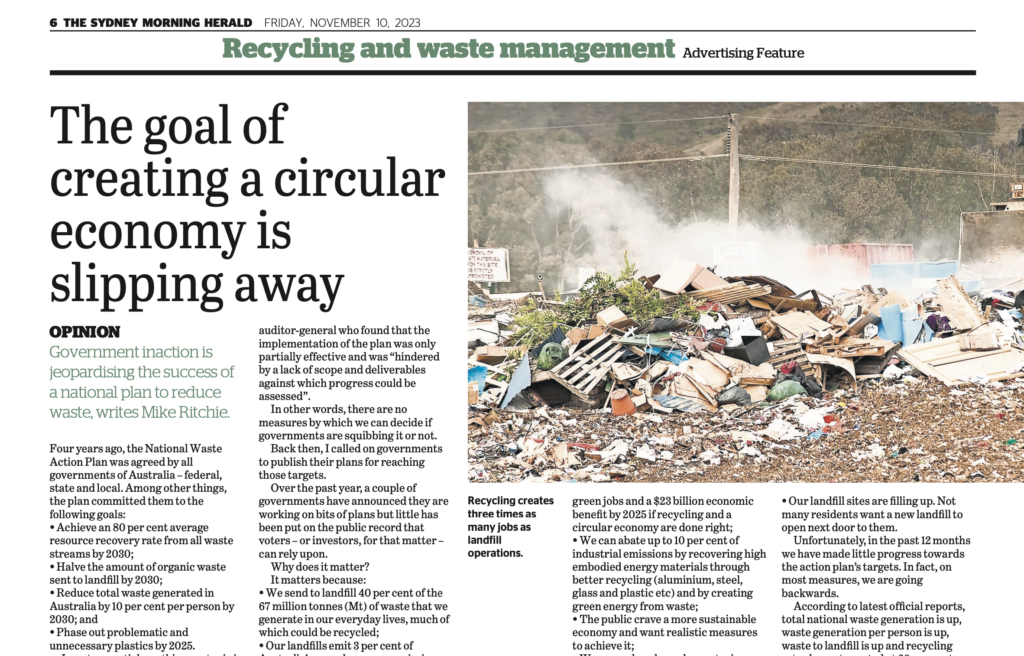The goal of creating a Circular Economy is slipping through our fingers
By: Mike Ritchie, MRA Consulting Group

In 2019 the National Waste Action Plan was agreed by all Governments of Australia – Federal, State and Local. The Plan committed all governments to achieving the following goals, amongst others:
- Achieve 80% average resource recovery rate from all waste streams by 2030;
- Halve the amount of organic waste sent to landfill by 2030;
- Reduce total waste generated in Australia by 10% per person by 2030; and
- Phase out problematic and unnecessary plastics by 2025;
I wrote an article on this very topic this time last year.
In that article I quoted the National Auditor General who found that the implementation of the Plan was only partially effective. The Auditor General found the Plan implementation was “hindered by a lack of scope and deliverables against which progress could be assessed”.
Put in my words:
“There are no measures by which we can decide if governments are squibbing it or not”.
I called for all Governments to publish their Plans to get to the Targets.
In the last year, a couple of governments have announced they are working on bits of plans but little that is on the public record that voters, or investors, can rely upon.
Why does it matter?
It matters because:
- We landfill 40% of the 67 million tonnes of waste that we generate in our everyday lives. Much of that could be recycled;
- Our landfills emit 3% of Australia’s greenhouse gas emissions or 11 MT;
- We can create over 17,000 new green jobs and a $23B in economic benefit by 2025 if recycling and a Circular Economy are done right;
- We can abate up to 10% of industrial emissions by recovering high embodied energy materials through better recycling (aluminium, steel, glass and plastic etc) and by creating green energy from waste;
- The public crave a more sustainable economy and want realistic measures to achieve it;
- We can reduce harm by capturing materials such as plastic that might otherwise be littered; and
- Our landfills are filling up. Not many residents want a new landfill to open up next door to them.
Unfortunately, in the last 12 months we have made little progress on the Targets. In fact, on most measures, we are going backwards.
Tweet
Total national waste generation is up, waste generation per person is up, waste to landfill is up and recycling rates have stagnated at 60% (a long way short of the Target 80%). (Source: latest National Waste Report, DCCEEW 2022)
Sure, there have been some great announcements, some project launches and investments by innovative companies. I don’t want to take away from the companies and Local Governments doing great things. Nor the people in State Governments trying to get policy change.
But so far, there is nothing happening on a scale needed to achieve the 80% recycling target nor the 50% recovery of organics.
Achieving the 2030 Targets and with them, a more sustainable, circular economy, requires significant government intervention and real changes in policy.
In 2023 we are already 11 MT/yr behind where we need to be to achieve the 80% Target.
Tweet
In fact, to achieve the 80% Target, taking into account economic and population growth that will occur in the intervening period, we need to capture an additional 18 MT/yr of recyclables by 2030.
The odd entrepreneurial project just will not cut it. We need action across all jurisdictions and across all waste streams. It needs to be coordinated by the Federal Minister Tanya Plibersek.

Industry and local councils know how to do it but they cannot invest without certainty and the right economic or regulatory signals from State and the Commonwealth Governments. Simple.
Governments should not be afraid of such intervention. The public overwhelmingly support action on waste and pollution.
Further, as Commonwealth Environment Minister Tanya Plibersek has stated in Parliament, this will be a jobs bonanza. We employ 3 times more people in recycling than we do in landfilling.
Industry and the private sector will make the $10-20B in investment to achieve the targets but only if the new businesses they create are sustainable. It is not rocket science.
So where should our effort go? Here are the main streams that we landfill each and every year:
- Commercial waste (including cardboard, plastic, steel and aluminium, glass) – 9 MT/yr;
- Organic waste including food – 7 MT/yr;
- Construction waste (including concrete, steel, masonry) – 6 MT/yr;
- Plastics – 2 MT/yr; and
- Textiles and clothing – 1 MT/yr.
(Source: National Waste Action Plan Database 2022; DEECCW).
“That is ridiculous!” I hear you say. “Those are resources, why do we landfill them?”.
Because current government policies and/or economic realities, make it cheaper or more convenient, to landfill compared to recycling.
We currently landfill 27 MT per year. If we want to recycle a big chunk of this, then we need to address the economics and policy settings.
Much as I love “War on Waste”, we need to do more than recycle coffee cups (2,000t/yr) or ban lightweight plastic bags (5,000t/yr). While “War on Waste” is great at motivating community action and driving aspiration, these cannot be a substitute for structural reform.
The main reform mechanisms include:
- Extended Producer Responsibility
- Product Design standards (reduce waste and ensure recyclability)
- Bans
- Market pricing
- Collection mandates
- Reprocessing and treatment infrastructure
- Reuse and Repair rules.
- Market development
Specifically, State governments should release (pithy) Plans on how they intend to achieve the Targets: Which waste streams? What infrastructure? Where, how and by when? Who is responsible?
Only then will they satisfy the Auditor General’s call for accountability.
But more importantly, if we fail this basic accountability test then we run the risk that the National Waste Action Plan will be seen as just more greenwashing. Great spin but little else.
It is too important for that. Doing it properly is the only way to harness the investment, create the jobs, reduce the emissions and put Australia on the path towards a more Circular Economy.
Mike Ritchie is the Managing Director at MRA Consulting Group.
This article has been published by The Age and SMH in a 10 November 2023 feature:




